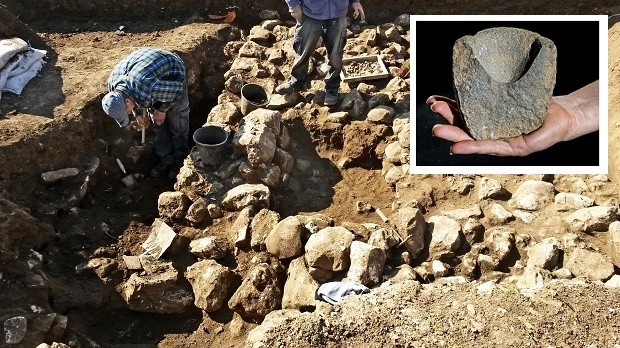Archeologists find oldest known Jerusalem settlement

This handout photo released by the Israel Antiquities Authority on Wednesday, Feb. 15, 2016, shows work on uncovering of an ancient settlement in Jerusalem. Israeli archaeologists have discovered a 7,000-year-old settlement in northern Jerusalem in what they say is the oldest discovery of its kind in the area. AP
JERUSALEM — Israeli authorities announced Wednesday they had uncovered findings proving for the first time the existence of an established human settlement in Jerusalem as far back as 7,000 years ago.
A dig in the annexed east Jerusalem neighborhood Shuafat revealed two homes with parts of walls and floors intact, as well as “pottery vessels, flint tools, and a basalt bowl” characteristic of the Chalcolithic era, the Israel Antiquities Authority said.
The discoveries came to light during road work in the area.
READ: Centuries-old coffins, skeletons found under New York street
Chalcolithic settlements have been found outside of Jerusalem, but prior to the Shuafat finding, only “fragmentary” remnants were unearthed in the city, according to the head of the authority’s prehistory branch, Amnon Barzilai.
“Now in the new dig we found remnants of a village, an established village,” he said.
In the Chalcolithic period humans were “still using stone tools, but began to create high-level ceramics and for the first time, copper tools as well,” said Ronit Lupu, director of excavations at the authority.
The authority earlier mistakenly named her as Ronit Lupo.
READ: ‘Wife of Jesus’ theory papyrus not fake – Harvard study
They were also forming “established settlements with economies,” Lupu said.
Researchers were long puzzled by the lack of hard evidence of Chalcolithic settlements in Jerusalem, which was a central route connecting the Dead Sea to the Mediterranean coast.
Chalcolithic settlements were found elsewhere in what is today Israel and Jordan.
Barzilai said the focus on Jerusalem’s later historical eras could have led to researchers overlooking the Chalcolithic period, considered by some a bridge between antiquity and modern human communal existence.
“Now we can know that even in the periods prior to the First and Second Temples, even in the Chalcolithic period, it was an inhabited area,” he said.
To Lupu, the new findings give closure to a long quest for Chalcolithic settlements in Jerusalem.
“For years in Jerusalem we had a feeling — we knew it was there somewhere but never found it. But here we found it,” she said.














